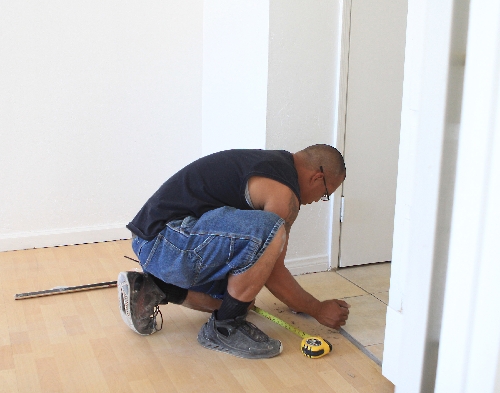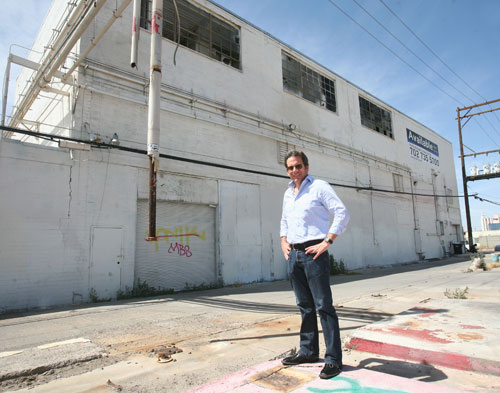Chances open up for Las Vegas downtown living space
Developer Jeff LaPour took an early shot at downtown redevelopment, buying the landmark Holsum bread factory on Charleston Boulevard in 2004 and converting it into Holsum Lofts, originally designed as a live-work project.
That didn't quite pan out.
LaPour's cost of renovation made it unfeasible for the residential component. The market at that time proved to be much stronger for commercial use, so LaPour leased the space to businesses that fit in with the burgeoning Arts District.
Today, Holsum is fully occupied, with a waiting list. Tenants include a design studio, art gallery, dance theater, architectural firm and Lola's Cafe. Many in the development community see it as a perfect example of adaptive reuse of a historic building.
Now LaPour wants to transform the dilapidated former Mission Linen warehouse at First Street and Coolidge Avenue into a $5 million mixed-use project in a joint venture with building owner Jim Page.
They will add another 10,000 square feet to the 30,000-square-foot building and develop about 50 residential units with a bar, restaurant and small offices.
While luxury condominium projects such as The Ogden, Newport Lofts and Juhl have struggled just a few blocks away, LaPour sees good demand for downtown housing - if it's the right product.
"The right kind of unique, vintage building reimagined as urban lofts," he said, standing next to the brick building with broken windows and rusted pipes hanging over the alley. "It's a completely different type of product. It's not new construction that you could find anyplace. It's an old industrial building. It comes with all the cool and interesting architectural elements that you cannot find today - wood truss roof, barrel vault ceilings, big open spaces. Think meatpacking district in New York."
The market for downtown housing has changed, he said.
"It's all there now, no longer a last resort for many, as it has been known,'' LaPour said.
TRANSFORMATIVE ENERGY
LaPour isn't the only champion of downtown living.
Sam Cherry found a small parcel at Las Vegas Boulevard and Hoover Avenue in 2004 and built the 120-unit SoHo Lofts. But his plans for another development, StanHi, never broke ground but he hasn't given up.
Cherry now plans to build 60 residential units, a grocery store and retail space at Stewart Avenue and 11th Street. His plan to convert old cargo containers into living space there may not be right for everyone, and his site isn't the best neighborhood. Still, projects like that and the SoHo Lofts transform neighborhoods, he said.
"When we started SoHo, it was rough. This neighborhood was like that. It takes people to come in and care about the community," Cherry said.
Before the real estate crash, San Diego-based CityMark Development heavily marketed the 340-unit Juhl mixed-use project on Bonneville Avenue, with prices starting in the mid-$400,000s. Several people bought in, but no one ever moved in. The $170 million project, financed by Corus Bank and developed on a ground lease from the city of Las Vegas, went bankrupt and was seized by the Federal Deposit Insurance Corp.
Now Juhl is showing signs of life. ST Residential, a division of Starwood Hotel Group, recently bought the project for $14 million. It's going to become a rental property, much like The Ogden, originally developed as Streamline Tower and also taken over by ST Residential.
"Juhl is a condo project with an HOA in place and in operation,'' said John Tippins, regional director for ST Residential. "We control the majority of the units in the building and we intend to rent our units due to the strength of the Las Vegas rental market. People who had units in escrow have the opportunity to close their units at their purchase price or work with ST on a settlement."
He would disclose neither the number of units in escrow, nor the target rental rate for Juhl. Similar projects such as SoHo and Ogden list rentals from $1,200 for a one-bedroom unit to $1,500 for two bedrooms and two baths.
Colliers International showed average rent downtown of $645 a month for one bedroom, $791 for two bedrooms and $904 for three bedrooms in the first quarter, compared with $665, $803 and $882, respectively, in the year-ago period.
Colliers research director John Stater said downtown apartment vacancy rates vary depending on the source, but all of the data he's seen has vacancy going down. He has it at 8.7 percent.
People are still moving to Las Vegas, and most of them go into multifamily housing, he said.
"The number of new residents in downtown is still unknown and could be fewer than many think," Stater said. "But as downtown becomes the hip place to be in Las Vegas, demand for high-quality multifamily in the area will rise."
ZAPPOS' MAGNETISM
Several factors are driving multifamily investment in downtown Las Vegas, from the renaissance movement spurred by the creation of the Arts District to multimillion-dollar developments such as The Smith Center for the Performing Arts and the new Las Vegas City Hall.
The latest force comes from online retailer Zappos.com, which is moving to the old city hall, bringing more than 1,500 employees downtown. That sparked a resurgence of business in the Arts District, Fremont East Entertainment District and emerging Third Street area. Zappos Chief Executive Officer Tony Hsieh has leased two entire floors at The Ogden.
Zappos will certainly help drive demand for more downtown housing, said Gary Banner, a multifamily broker for Colliers International.
"Downtown will be one of the first sub-markets in Las Vegas to experience true population growth and positive absorption of available rental units," Banner said. "The smart-money people are now seeking development opportunities and have quietly begun acquiring multifamily parcels for future development."
The most recent application for multifamily development came in September for 330 units near Casino Center Drive and Coolidge Avenue, said Flinn Fagg, director of planning development services for the city of Las Vegas. The city has about 2,900 approved downtown housing units on the books, but none of the projects has broken ground, he said.
Barnet Lieberman, a New York investor who acquired five blocks downtown for a live-work project, has 1,100 units approved at Charleston and Fourth Street. Another 700 units are planned at Gass Avenue and First Street; 352 units at Fremont and Eighth; 296 units at Bonanza Road and Main Street; and 130 units at Hoover and First.
Spence Ballif, multifamily specialist for CB Richard Ellis, said that other than high-rise condos that reverted to rentals, not much residential development has taken place downtown in the past decade.
He said it's unlikely that there will be much new construction beyond the units already permitted.
"The hard part is to buy land down there. It's still expensive," Ballif said. "If you're doing a midrise with 50 units an acre, it's really expensive. You can't do garden-style because the land's not there and it's not the highest and best use."
THINKG RESIDENTIAL
The Great Recession turned many Las Vegas homeowners into renters, and some are migrating downtown for the urban lifestyle. But it's not for everyone, said Nasser Daneshvary, director of Lied Institute for Real Estate Studies at the University of Nevada, Las Vegas.
"I think it's going to be successful in becoming a central business district, but I don't think the residential part will be successful anytime soon," Daneshvary said. "This town is not New York or St. Louis or Chicago. It's a very short drive, 30 minutes to go anywhere, and single-family homes are basically undervalued and will be that way for a while. Most people, if they have a choice, they'll take a home over a condo. Rents (elsewhere) are still affordable for single-family homes."
Downtown is not very attractive to professionals who make more than $60,000 a year, Daneshvary said. The median income of ZIP code 89101 - the heart of downtown - is $22,900, and only about one-fifth of the population has earned a college degree, he said.
But where Daneshvary sees a challenge, Robert Fox and Daniel Gaeta see a demographic sweet spot. They bought a 10-unit apartment complex at 1101 Clark St. for $165,000 through an online auction. It will take another $30,000 to refurbish the units, including new tile and laminate flooring and fresh paint inside and out.
They'll rent the six one-bedroom units for about $550 a month and four two-bedrooms units for $650, the going rate for downmarket housing in that neighborhood.
"I think it's a good investment and we'll get a good return," said Fox, who also bought a fourplex near the Stratosphere. "I like the building, where it was at, the trees in front, and the building was not in that bad condition. We looked at a number of them and this one fit the bill."
Although financing is a problem for big projects, mom and pop investors like Fox and Gaeta are coming in with all-cash transactions. Fox said he's "perfectly happy" investing in downtown Las Vegas and would prefer to buy there as opposed to other areas.
THE DRAW OF DIVERSITY
"The great thing about downtown is the diversity," said LaPour, whose developments include the Element hotel, LaPour Corporate Center and several commercial centers around Las Vegas. "Old and young, married and single, male and female, gay and straight, professionals and service sector workers."
The downside, he said, is that downtown is becoming "gridlocked," he said.
Property owners are waiting for prices to escalate, and most will likely overplay their hand, just as they did in the last cycle, LaPour said.
"Everybody now has dollar signs in their eyes," he said. "Many property owners are not realistic on value. A lot think Zappos or Tony (Hsieh) will buy them out. When they figure out that (Zappos and Hsieh) don't need everything, I hope it gets more realistic. It's only as valuable as what the market demands to be built there, similar to the high-rise phenomenon."
LaPour said the "path of least resistance" in Las Vegas has always been to knock down old buildings such as the Mission Linen warehouse, which needs extensive renovation to bring it up to code. He went through that with Holsum Lofts.
"I get amnesia when the project is complete and only remember the good times. That's why I do it again," he said. "Five guys told me I'd have to demolish Holsum and the sixth guy said we can save it. It costs a lot to save these. It's a complicated jigsaw puzzle. We have a lot more experience than we did back in 2004 and the city has a lot more experience. It's a different environment today, but code is code. You can never get around that."
Contact reporter Hubble Smith at hsmith@reviewjournal.com or 702-383-0491.























